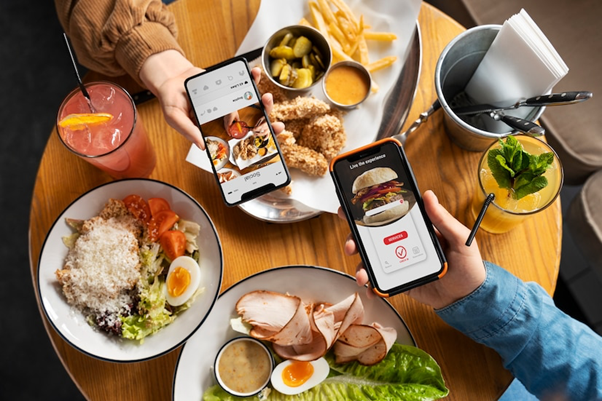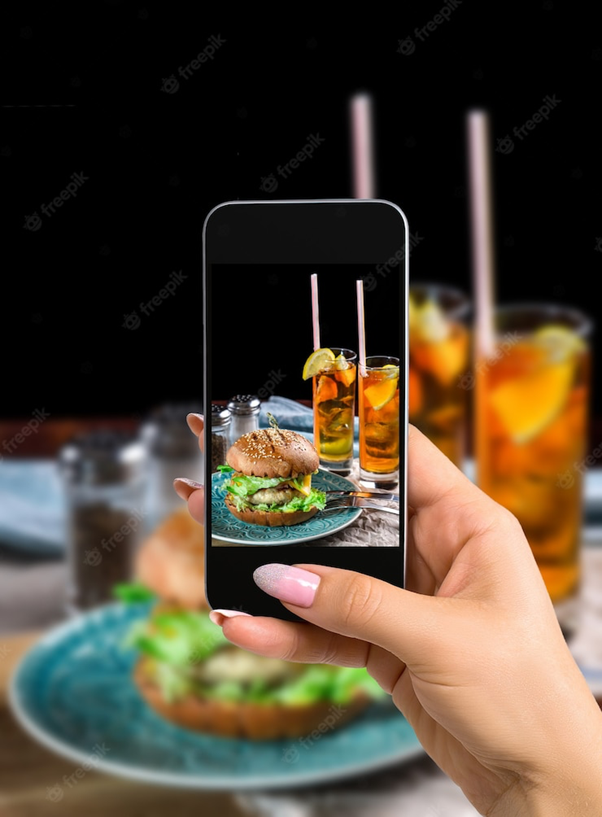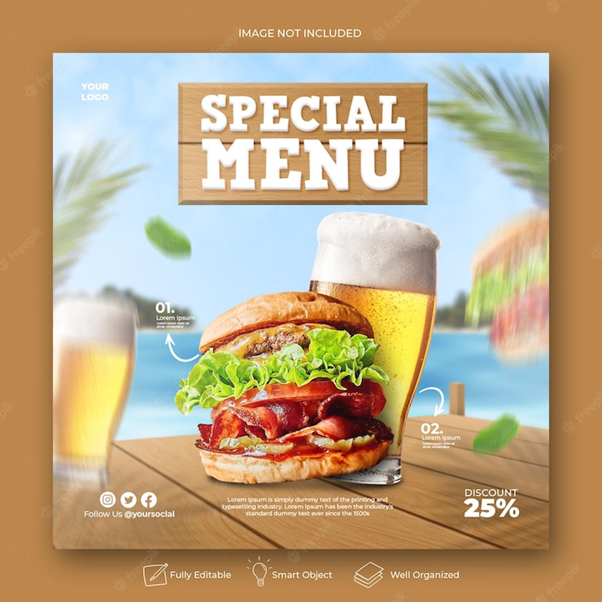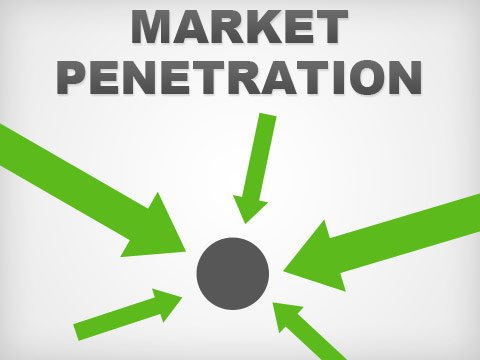In a world where competition is fierce and consumer preferences are constantly evolving, effective marketing food and beverage has become more crucial than ever. The Statista Research Department report says that the food and beverage e-commerce revenue will surpass 47 billion dollars by 2025. The online food and beverage consumer base is around 150 million people, which is close to half of the population of the United States of America.
Studies like these simply reaffirm what we know- that the food and beverage industry is among the world’s most dynamic industries. Right from the way food and beverage companies source their raw materials to the way consumers are ordering food and making payments online, the industry is now completely digitized.
Add to it that this industry is quite competitive with low entry barriers. So, what you need is a robust strategy for marketing food and beverage to help your business stand out and add to your revenues.
This blog shares everything that you need to know about marketing food and beverage and how to make it work for you.
Why Does the Food and Beverage Industry Need a Specialized Growth Marketing Strategy?
Earlier, people mostly consumed food and beverages by either dining at a local restaurant or cooking food at home.
Now, every time you open your social media pages, you are bound to see your family and friends’ reviews of a food and beverage company. It isn’t just limited to your circle of people.
Millions of millennials are now using digital platforms to experiment and review food and beverages businesses.
Factors such as the advent of technology and the recent pandemic, more and more people are ordering food through food apps. Now, word-of-mouth communication is not sufficient anymore to gain more customers.
That’s precisely why investing time and resources in niche growth marketing strategies is also equally important.
Before we talk about some of the top F&B marketing strategies, it is essential to understand how growth marketing will help your business.
Just like every industry has different marketing needs, the demands and target audience of the food and beverage industry are also unique. The last three years have been a time of exponential change and the realization that growth marketing is the only key to the success, survival, and growth of food and beverage companies.
Here are some reasons why this industry benefits from specialized growth marketing strategies:
Your Customers Get to Know You
Getting more people to know about your business is difficult.
But what if they come to you?
Studies have revealed that nearly half of consumers (48%) use social media to look for places to eat and drink.
With thousands of food and beverage companies existing, you can’t expect the customers to know about them all.
Growth marketing allows you to be seen by people in your specific target segments. For instance, you may be offering clean and healthy products that most consumers look for. But because you aren’t present online, no one gets to know about your offerings.
Moreover, it has more benefits. If you own a café, you can share your location, timings, and special offers online.
You Reach New Customers via Marketing Food and Beverage
While you may have a set of loyal customers, to allow your business to grow, you don’t just need these customers to come back but also require new ones.
Having growth marketing strategies improves your reach to customers who otherwise wouldn’t have interacted with your business.
This has a spiraling effect too. Since most people look for online recommendations from their friends about new places to eat, you can expect to reach a higher number of people.
You Engage Better With Your Consumers
Forbes says that consumers are four to six times more likely to purchase from companies that are purpose-driven, offer valuable interactions, and are what they can trust.
Growth marketing allows you to have meaningful and close-up interactions with customers about your brand ethos.
This builds familiarity, and trust, and ultimately brings in more customers in the long run.
You Can Measure the Results Instantly
One of the top benefits of growth marketing strategies is that they are instantly measurable. You can use real-time analytics to track various metrics such as customer engagement, sales data, and website and social media interactions.
This helps you not just assess your returns on investment (RoI) but also helps you make timely changes to your decisions. These include adjusting your messaging, reaching out to more specific audiences, and becoming more agile while responding to your customers.
Improve Your Profitability
With the help of growth marketing strategies, you can reach your customers directly and eliminate the middlemen.
You can also reach more customers and extend your presence to high-volume markets. These strategies also help you build a more loyal customer base that keeps coming back to your business.
What do all these help with?
You now can hold on to your prices without having to chase customers. When you do that, your profit margins improve.
You Safeguard Yourself From Product Failures
According to a report citing Harvard Business School, each year almost 30,000 food and beverage products are launched and 80 percent of them fail. This may turn out to be a costly mistake in terms of your brand’s goodwill and loss of money.
Most food and beverage companies fight tooth and nail to avoid this.
Having mindful growth marketing strategies insulates you against this very loss. They allow you to know what your customers want from a potential product and how much they are willing to pay for it.
They also help you to introduce and test your new product with a few customers before you launch it in your target markets.
Top Strategies Marketing Food and Beverage for Your Industry
You now know that F&B marketing helps you be creative while reaching new customers and gauging how your presence and new products are faring.
Let’s now look at the top eight growth marketing strategies that will help your business succeed and ace the market’s ups and downs:
- Know How Your Presence Looks Online
You can create an online presence without understanding what you currently look like to the consumers.
That’s why, before you can roll out your food and beverage marketing plan, it is important to know and audit your current online presence. Here are some questions that you should answer at the outset:
- How is your brand known and what does it stand for?
- How is your presence on search engine result pages?
- Is there any outdated information floating about you in the market?
- Are you communicating complete and correct information about, say, your location and business hours?
Having said that, only auditing your presence won’t do. You also need to know how and where your nearest competitors stand. This will help you:
- Outline your objectives, develop a strategic plan, carve out the budget, and measure the returns.
- Know the opportunities that your business may have missed.
- Understand where you are beating the competitors and vice versa.
- Know the new trends in consumer behavior and what are they liking more.
- Build a Great Website
When a person is hungry, they are most likely to turn to their smartphone for recommendations for places to eat.Forbes verifies that there are over one billion restaurant searches on Google every month. Out of these one billion, around 89 percent are done on a smartphone.
Now, imagine your business getting missed during all these searches.
Having an interactive website ensures that your business is ‘searchable’ and integrated with your social media channels. Important elements of an F&B business’ website are:
- Your menus and nutritional facts
- Contact information and location
- Business hours
- Recipes
- Build Your Social Media Presence

The International Journal of Research and Review says that close to 76 percent of youth follow popular food and beverage pages on social media.
Today, when millions of conversations happen on social media platforms like Facebook, Instagram, and Twitter, ignoring them can be a costly mistake. These platforms are especially great spaces to share good food visuals, which can often turn into impulse purchases and hence more sales for your business.
Here are some ways to enhance your F&B marketing strategy:
- Position your product in the right context. You could focus on its health aspects or its sustainable production processes.
- Encourage social media users to share their experiences and reviews of your offerings through pictures and videos.
- Use social media ads to drive qualified leads to your website.
- Connect with social media influencers to create conversations around your brand.
- Use PPC to Get Ranked at the Top in Search Engines.
Research says that food is the most popular category when it comes to internet searches that contain the phrase ‘near me. This is done by consumers when they are looking for a place to eat or drink nearby.
It is no longer enough to just have a website or social media pages. You also need to optimize them so that they appear amongst the top results.
One of the best ways to rank at the top while people search for related businesses online is to use PPC (Pay-per-click) for restaurant SEO optimization. This advertising is a sure-shot way to drive traffic to your website and boost conversions.
Here is what our experts recommend:
- Create good-quality content and keywords that resonate with your business.
- Highlight any health or environmental benefits that your offerings may have.
- Use the Power of Visuals and Video Marketing

Research says that one of the top things that makes a consumer choose a particular food and beverage option is the visual design used by that business. Speaking of visuals, this also turns out to be a top food and beverage marketing strategy.
Good visuals and video content help you share interesting narratives with your current and prospective consumers. You can tell captivating stories that not just showcase your offerings but also connect and engage with your audience.
Some visuals that work the most are:
- Sustainability of your food production processes.
- Farm-to-table stories
- Nutritional value of your offerings.
- Story of the brand.
- Rope in Influencers and Celebrities
One of the biggest influences on young people today is social media celebrities and influencers. They are content creators who have a large following on multiple social media platforms. Research says that these influencers act as opinion leaders and have an impact on which food and beverage companies these millennials choose.
For example, research verifies that food bloggers have four times as many followers as any other industry.
They are also trusted by consumers for their content and can help you develop a robust F&B marketing strategy to achieve omnichannel growth.
To leverage the influence of a social media influencer, you will have to establish the targeted CPM (Cost Per Mille). The next step is to analyze their viewership across platforms and over the last ten posts. This will help you determine the kind of reach that you can expect for your posts.
- Use Contests and Giveaways to Gratify Your Consumers

Another very powerful food and beverage marketing strategy is creating a calendar of contests, special offers, and giveaways.
Who doesn’t love to get a good bargain on their purchase? Likewise, getting gratified by a business is a great feeling.
This is exactly how contests and giveaways help in F&B marketing.
You can take advantage of holidays to offer seasonal promotional offers. These could be holiday-themed menus or limited-offer foods. Such offers create urgency while helping them feel that they are partaking in something very special offered by their favorite food and beverage business.
Another interesting way to roll out these offers is to participate in local or regional events. These could be drink or music festivals where you expect your prospective customers to turn up.
Advertise these on your website and social media platforms to drive traffic to your business and create an engagement with your products.
- Stay on Top of Your Reviews
The Journal of Hospitality and Tourism Technology says that consumers who see positive reviews about food and beverage have a higher intention to visit a restaurant or café.
That brings us to a very important food and beverage marketing strategy- paying attention to your online reviews. Every business wants to know how they are being perceived in the market by their existing and targeted consumers. This is exactly what your reviews tell you.
That’s not all, online reviews also build trust in your brand and reassure consumers that they are making the right decision while investing in your business.
Encourage consumers to leave reviews about their experience with your business. Most people get motivated by incentives. These could be discounts or freebies when they buy something off your menu.
When you have positive reviews, ensure that you politely thank people for them. On the other hand, negative reviews must be dealt with professionally. Never protest or argue with people on social media platforms. Instead, be open to discussing the issues and resolving them professionally and promptly.
Summing Up
Considering the humongous changes in the way people are interacting with brands in the last few years, food and beverage businesses have to be more agile. You need to plan your growth marketing strategies only after adequate planning and research. Remember, measuring your success is equally important to know how your campaigns are working and if you need to tweak them. Lean Summits helps you develop dynamic strategies to help you fuel your business growth and survive market disruptions. Connect with us today to know more about how we can help.


